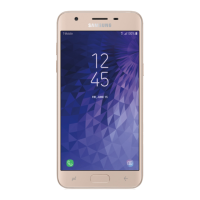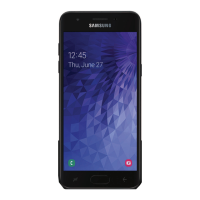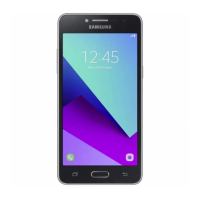Do you have a question about the Samsung Galaxy J3 Prime and is the answer not in the manual?
Describes the side speaker feature of the device.
Guides on initial setup, including hardware assembly and basic configuration.
Instructions on powering on, off, locking, unlocking, and restarting the device.
Identifies and explains the external components of the device's front.
Identifies and explains the external components of the device's back.
Overview of the main screen layout, status bar, and app shortcuts.
Explains the icons and information displayed in the device's status bar.
How to view and manage notifications and quick settings on the device.
Details on gestures like tap, double-tap, swipe, drag, and pinch for device interaction.
Explains basic command options like delete, share, edit, and checkbox usage.
Instructions on using the QWERTY keyboard, predictive text, and special keys.
How to use voice input for text entry with Google Voice Typing.
Steps to activate the multi-window feature for split-screen multitasking.
How to launch and manage apps in split-screen view for multitasking.
Procedure to enable emergency mode for power conservation in critical situations.
Details on available features like flashlight, alarm, and emergency calls in this mode.
How to find and launch all applications installed on the device.
Steps to remove downloaded applications or disable preloaded ones.
Methods to arrange app shortcuts alphabetically or in custom order, and use folders.
How to perform basic arithmetic operations using the calculator app.
Instructions for using the advanced functions of the Scientific calculator mode.
Procedure to add existing calendars from various accounts to the Calendar app.
Options to change the display view of the calendar (Year, Month, Week, Day).
Guides on using the camera to capture photos, including focus and brightness adjustments.
Instructions for recording videos, including capture, pause, resume, and stop functions.
How to set, configure, and manage alarms, including tone, volume, and snooze.
How to list and remove cities to track time in multiple locations globally.
Step-by-step guide to creating and saving new contact entries on the device.
How to modify existing contact information, add fields, or delete entries.
Organizing contacts into groups for easier management and communication.
Instructions for composing, addressing, attaching files, and sending emails.
Tools for reading, replying, sorting, searching, and managing emails in the inbox.
How to browse, view, and manage photos and videos stored on the device.
Tools and options for editing photos, including cropping and rotating.
Using the Chrome browser for internet access, bookmarks, and tab management.
Navigating and finding locations using Google Maps, requiring location services.
How to open and use the web browser for internet access.
Steps to enter web addresses, navigate, and zoom on websites.
Guide to composing, sending, and attaching media to text and multimedia messages.
How to select and remove individual or multiple messages from the device.
Accessing and navigating through stored files organized by categories or recent access.
Using options like search, clearing history, and managing storage within the file manager.
Instructions on initiating calls using the dialer, contacts, or recent call logs.
How to accept or decline incoming calls using swipe gestures or screen taps.
Dialing emergency numbers regardless of service status.
Accessing emergency dialing even when the device is locked for immediate help.
How to add additional callers to an active call for conference calls.
Scanning for and connecting to available Wi-Fi networks using the device.
Steps to manually add and configure new Wi-Fi networks.
Establishing direct device-to-device connections using Wi-Fi without a network.
Process of establishing trusted wireless connections with other Bluetooth devices.
Enabling data saver to reduce background data usage and frequency.
Activating or deactivating mobile data connectivity for internet access.
Setting up the device as a Wi-Fi hotspot to share its internet connection.
Connecting other devices to the mobile hotspot using Wi-Fi settings.
Selecting how the device determines its location (High accuracy, Battery saving, Device only).
Adding, editing, or deleting VPN connections for secure network access.
Switching between Sound, Vibrate, and Mute modes for notifications and alerts.
Adjusting system volume levels for ringtones, media, notifications, and system sounds.
Disabling notifications for specific applications or all apps.
Configuring notification settings like allowance, silence, and priority per application.
Adjusting screen brightness levels, including outdoor mode for visibility.
Setting screen zoom level and font size/style for improved readability.
Customizing the home screen layout, shortcuts, widgets, and wallpapers.
Displaying icons with or without shaded frames on the home and app list screens.
Changing the device's look by applying wallpapers to home and lock screens.
Applying visual themes to customize the appearance of screens, wallpapers, and app icons.
Improving device performance by clearing memory, deleting files, and scanning for malware.
Monitoring battery usage, enabling power saving modes, and managing app power consumption.
Viewing device memory usage, managing internal storage, and SD card operations.
Adding and managing multiple languages for the device interface and apps.
Enabling or disabling different virtual keyboard layouts and options.
Setting and managing the device's date, time, and time zone settings.
Restoring device settings to factory defaults, excluding security, language, and accounts.
Resetting Wi-Fi, Mobile data, and Bluetooth settings to their defaults.
Setting up screen lock types (Swipe, PIN, Pattern, Password) for device security.
Remotely locating, locking, or erasing the device in case of loss or theft.
Managing data backup, restore, and sync settings for Samsung accounts.
Steps to add and manage various account types like Google, email, and social networks.
Features to assist with visual aspects, like dark screen, zoom, and contrast settings.
Settings for hearing assistance, including flash notifications and subtitle options.
Adjusting screen layout for easier operation with one hand using gestures or buttons.
Accessing video tutorials for device usage and features.
Links to Samsung's official support website for assistance and resources.
Important legal notices, arbitration agreements, and warranty information.
| Display Size | 5.0 inches |
|---|---|
| Resolution | 720 x 1280 pixels |
| Processor | Exynos 7570 Quad |
| RAM | 1.5 GB |
| Internal Storage | 16 GB |
| Rear Camera | 5 MP |
| Front Camera | 2 MP |
| Battery Capacity | 2600 mAh |
| Operating System | Android 7.0 Nougat |
| Expandable Storage | microSD up to 256 GB |
| Weight | 148 g |
| Dimensions | 140.9 x 70.1 x 8.7 mm |











